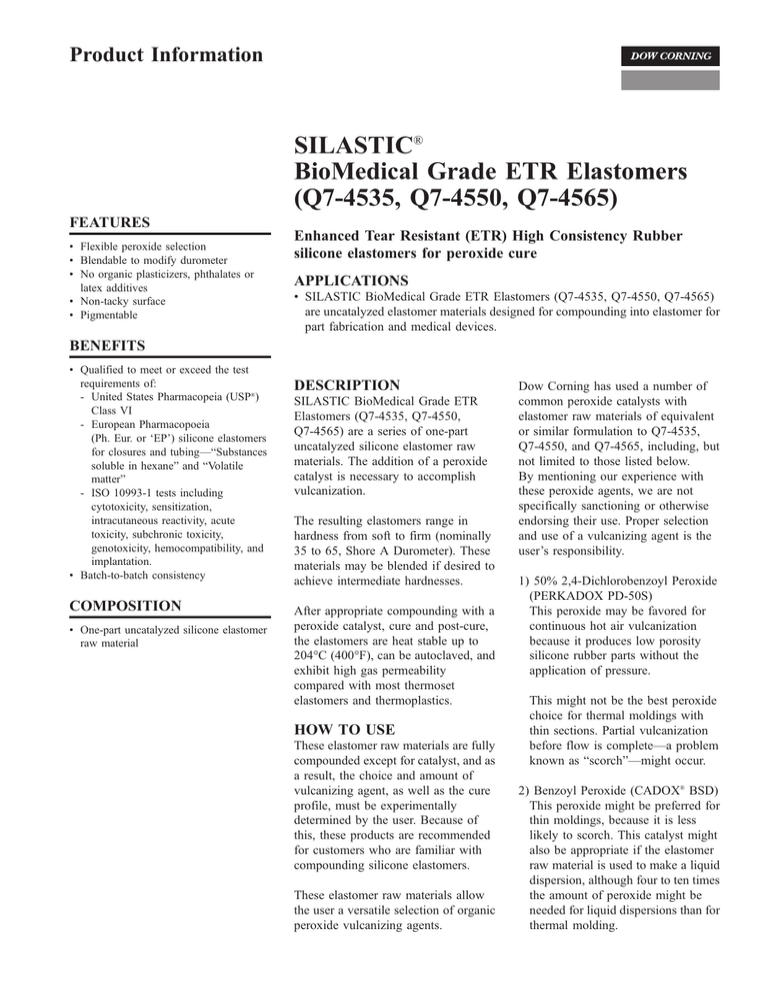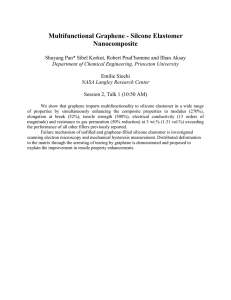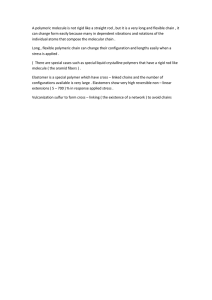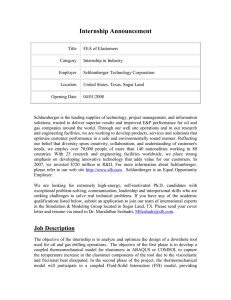
Product Information
FEATURES
" Flexible peroxide selection
" Blendable to modify durometer
" No organic plasticizers, phthalates or
latex additives
" Non-tacky surface
" Pigmentable
SILASTIC®
BioMedical Grade ETR Elastomers
(Q7-4535, Q7-4550, Q7-4565)
Enhanced Tear Resistant (ETR) High Consistency Rubber
silicone elastomers for peroxide cure
APPLICATIONS
" SILASTIC BioMedical Grade ETR Elastomers (Q7-4535, Q7-4550, Q7-4565)
are uncatalyzed elastomer materials designed for compounding into elastomer for
part fabrication and medical devices.
BENEFITS
" Qualified to meet or exceed the test
requirements of:
- United States Pharmacopeia (USP®)
Class VI
- European Pharmacopoeia
(Ph. Eur. or EP) silicone elastomers
for closures and tubingSubstances
soluble in hexane and Volatile
matter
- ISO 10993-1 tests including
cytotoxicity, sensitization,
intracutaneous reactivity, acute
toxicity, subchronic toxicity,
genotoxicity, hemocompatibility, and
implantation.
" Batch-to-batch consistency
COMPOSITION
" One-part uncatalyzed silicone elastomer
raw material
DESCRIPTION
SILASTIC BioMedical Grade ETR
Elastomers (Q7-4535, Q7-4550,
Q7-4565) are a series of one-part
uncatalyzed silicone elastomer raw
materials. The addition of a peroxide
catalyst is necessary to accomplish
vulcanization.
The resulting elastomers range in
hardness from soft to firm (nominally
35 to 65, Shore A Durometer). These
materials may be blended if desired to
achieve intermediate hardnesses.
After appropriate compounding with a
peroxide catalyst, cure and post-cure,
the elastomers are heat stable up to
204°C (400°F), can be autoclaved, and
exhibit high gas permeability
compared with most thermoset
elastomers and thermoplastics.
HOW TO USE
These elastomer raw materials are fully
compounded except for catalyst, and as
a result, the choice and amount of
vulcanizing agent, as well as the cure
profile, must be experimentally
determined by the user. Because of
this, these products are recommended
for customers who are familiar with
compounding silicone elastomers.
These elastomer raw materials allow
the user a versatile selection of organic
peroxide vulcanizing agents.
Dow Corning has used a number of
common peroxide catalysts with
elastomer raw materials of equivalent
or similar formulation to Q7-4535,
Q7-4550, and Q7-4565, including, but
not limited to those listed below.
By mentioning our experience with
these peroxide agents, we are not
specifically sanctioning or otherwise
endorsing their use. Proper selection
and use of a vulcanizing agent is the
users responsibility.
1) 50% 2,4-Dichlorobenzoyl Peroxide
(PERKADOX PD-50S)
This peroxide may be favored for
continuous hot air vulcanization
because it produces low porosity
silicone rubber parts without the
application of pressure.
This might not be the best peroxide
choice for thermal moldings with
thin sections. Partial vulcanization
before flow is completea problem
known as scorchmight occur.
2) Benzoyl Peroxide (CADOX® BSD)
This peroxide might be preferred for
thin moldings, because it is less
likely to scorch. This catalyst might
also be appropriate if the elastomer
raw material is used to make a liquid
dispersion, although four to ten times
the amount of peroxide might be
needed for liquid dispersions than for
thermal molding.
3) 2,5-Dimethyl-2,5-di(t-butylperoxy)
Hexane (VAROX® DBPH) preferred
for molded parts with thick sections,
this vulcanizing agent can produce
elastomers with good tensile strength
and elongation and low compression
set.
4) Dicumyl Peroxide (DI-CUP R)
This is another vulcanizing agent
favored for thick section molding.
It also produces elastomers with low
compression set.
®
5) Tert-butyl peroxybenzoate (TBPB).
This agent is typically used to
generate sponge-type rubbers.
Catalyst Addition and
Blending
Typically, a two-roll mill is used for the
blending process. If the elastomer stock
has been stored in the cold, warming to
room temperature before unwrapping
could help avoid condensation on the
elastomer, which might cause voids in
molded or extruded parts.
The stock should be softened to a
smooth consistency on a two-roll mill.
Then the peroxide is added and
thoroughly blended into the stock,
using care not to generate excess heat.
Use of insufficient vulcanizing agent
will result in undercured elastomer that
is soft or cheesy (crumbly and noncohesive), unsuitable for its intended
purpose. The amount of peroxide to
use will vary with operating
conditions. Table 1 provides suggested
starting amounts, however the amount
of peroxide needed for a given
application cannot always be predicted
by stoichiometry or laboratory
experiment because peroxide may be
lost (by evaporation, oxidation and
other means) from the elastomer before
vulcanization is complete. It might be
necessary to determine the amount of
vulcanizing agent through experiment
using the same elastomer raw materials
and equipment that will be used for
production.
It is the responsibility of the user to
observe all precautions for the safe
handling of the peroxide. Appropriate
removal of the peroxides
decomposition products is also the
users responsibility
Pigmenting and Cross
Blending
Cross blending any combination of this
series of stocks on a two-roll mill will
give elastomers of intermediate
durometer (hardness). Pigmenting can
be accomplished by milling the
pigment into the stock on a two-roll
mill. Toxicity and suitability of the
pigment for the application should be
checked by the user.
Molding
These elastomers can be molded using
standard techniques of compression or
transfer molding. It might be necessary
to determine the amount of vulcanizing
agent and molding conditions through
experiment using the same materials
and equipment that will be used for
production. The proportions and
conditions given in Table 1 are
suggested starting points. The optimal
parameters can only be determined
through experimentation.
All equipment should be thoroughly
cleaned at the end of each use to avoid
a build-up of cured stock, which is very
difficult to remove. The residue might
result in crumbs of elastomer being
picked up by the next batch, causing
gels and imperfections.
Calendering
After blending with peroxide catalyst,
these elastomer stocks may be
calendered into sheeting with or
without reinforcement. Non-reinforced
sheeting is usually made by
calendering onto a liner, which is
stripped off after vulcanization.
Suitable liner materials include
cellulose (e.g., Kodacel) and polyester
(e.g., Mylar®) films and Holland cloth.
If Cadox TS-50 is used, the
recommended vulcanizing temperature
is 116°C (241°F).
SILASTIC BioMedical Grade ETR Elastomers (Q7-4535, Q7-4550, Q7-4565)
2
Ref. no. 51-0602C-01
For this system, the usual vulcanizing
time is 10 minutes for a sheet about
3 mm (1/8 inch) thick, and an
additional three minutes for each
additional 3 mm (1/8 inch). If a linear
film (e.g., Kodacel or Mylar) is used, it
should be removed while the sheet is
still warm. If Holland cloth is used,
soak in warm water to remove. The
vulcanized sheeting should be post
cured.
Extruding
These elastomers can be extruded to
make profiles such as filament (rod)
and tubing. Extrusion can also make
wire coating. A vulcanizing agent of
the 2,4-dichlorobenzoyl peroxide-type
(such as PERKADOX PD-50S) may
be used with these elastomer bases to
help prevent the formation of gas
bubbles in the extruded profile.
The extrusion of silicone elastomers
(which are thermosetting) is generally
accomplished using no heat in the
barrel, and hot air vulcanization
chambers downstream of the die.
For processing ease, compounded
stock should be thoroughly softened on
a two-roll mill the day of extrusion.
The durometer (hardness) and
mechanical properties (e.g., tensile
strength) of extruded products may be
lower than values obtained on molded
test slabs.
Post-curing
Elastomers vulcanized with peroxide
agents must be post-cured. Post-cure
provides two important benefits:
1) Post-cure helps remove residual
byproducts generated from the
decomposition of the peroxide
vulcanization agent. If not properly
removed, some of these residues can
adversely affect biocompatibility of
the elastomer.
2) Post-cure stabilizes and enhances
elastomer physical properties.
Post-curing can be accomplished by
heating the fabricated part in a hot-air
circulating oven to the required
temperature for the required length of
time. The time required for post-curing
at a given temperature depends upon
the rate at which the volatiles evolve
from the elastomer, which in turn
depends upon thickness of the part and
the exposed surface area. As an
example, a molded standard 1.905mm
(0.075 inch) thick ASTM slab should
be post-cured in a hot-air circulating
oven at 177°C (350°F) for
2 hours when catalyzed with
PERKADOX PD-50S.
materials for all intended uses. While
these materials have passed screening
tests that are applicable to products
intended to be implanted for up to
29 days, Dow Corning makes no
end-use representation based on such
testing. Nor does Dow Corning make
any representation concerning the
suitability of these products for
applications of greater than 29 days
of implantation in the human body.
QUALIFICATION TESTING
For ordering and product information,
contact your local Dow Corning
Global Connection.
The results of selected qualification
tests are shown in Table 4.
Summaries of Health Data are
available upon request.
QUALITY
SILASTIC BioMedical Grade ETR
Elastomers are manufactured using
appropriate principles of Good
Manufacturing Practice (GMP)
requirements. Dow Corning is globally
registered to the ISO 9001 Quality
Standard. Registration certificate
number FM 10734 has been obtained
through the British Standards
Institution (BSI). Certification to
ISO 9001 through an independent third
party indicates that Dow Corning
operates a quality management system
in accordance with the standard,
ensuring full documentation and
traceability.
REGULATORY STATUS
SILASTIC BioMedical Grade ETR
Elastomers, when properly catalyzed,
cured and post-cured, and thoroughly
cleansed, may be used in accordance to
the requirements of FDA regulation
21 CFR 177.2600, "Rubber Articles
Intended For Repeated Food Contact".
IMPORTANT
INFORMATION
THE USER'S ATTENTION IS
IN PARTICULAR DRAWN TO
THE FOLLOWING
STATEMENT:
It is the User's responsibility to ensure
the safety and efficacy of these
ORDERING AND PRODUCT
INFORMATION
HANDLING PRECAUTIONS
Product safety information required
for safe use is not included.
Before handling, read product and
safety data sheets and container labels
for safe use, physical and health hazard
information. The material safety data
sheet is available on the Dow Corning
website at www.dowcorning.com.
You can also obtain a copy from your
local Dow Corning sales representative
or Distributor or by calling your local
Dow Corning Global Connection.
USABLE LIFE AND
STORAGE
When stored at or below ambient
temperature in the original unopened
containers, these products have a
usable life of 24 months from the date
of production.
PACKAGING
SILASTIC BioMedical Grade ETR
Elastomers (Q7-4535, Q7-4550,
Q7-4565) are supplied in boxes of
11.3kg (25 lb). Additionally, Q7-4550
is available in a 408.2kg (900 lb) box.
Each box contains uncatalyzed
elastomer stock sealed in polyethylenewrapped bundles of 11.3kg (25 lb).
HEALTH AND
ENVIRONMENTAL
INFORMATION
To support Customers in their product
safety needs, Dow Corning has an
extensive Product Stewardship
SILASTIC BioMedical Grade ETR Elastomers (Q7-4535, Q7-4550, Q7-4565)
3
Ref. no. 51-0602C-01
organization and a team of Product
Safety and Regulatory Compliance
(PS&RC) specialists available in each
area.
For further information, please see our
website, www.dowcorning.com or
consult your local Dow Corning
representative.
LIMITED WARRANTY
INFORMATION - PLEASE
READ CAREFULLY
The information contained herein is
offered in good faith and is believed
to be accurate. However, because
conditions and methods of use of our
products are beyond our control, this
information should not be used in
substitution for customers' tests to
ensure that Dow Corning's products are
safe, effective, and fully satisfactory
for the intended end use. Suggestions
of use shall not be taken as
inducements to infringe any patent.
Dow Corning's sole warranty is that the
product will meet the Dow Corning
sales specifications in effect at the time
of shipment.
Your exclusive remedy for breach of
such warranty is limited to refund of
purchase price or replacement of any
product shown to be other than as
warranted.
DOW CORNING SPECIFICALLY
DISCLAIMS ANY OTHER
EXPRESS OR IMPLIED
WARRANTY OF FITNESS FOR
A PARTICULAR PURPOSE OR
MERCHANTABILITY.
DOW CORNING DISCLAIMS
LIABILITY FOR ANY
INCIDENTAL OR
CONSEQUENTIAL DAMAGES.
We help you invent the future."
www.dowcorning.com
Table 1: How to use catalysts with SILASTIC BioMedical Grade ETR Elastomers (Q7-4535, Q7-4550, Q7-4565)
Catalyst
Parts catalyst per 100 parts base1
Molding conditions
minutes/degrees
DI-CUP R
0.5
10/160°C (320°F)
PERKADOX PD-50S
1.0
5/115°C (239°F)
VAROX DBPH
1.0
10/171°C (340°F)
CADOX BSD
1.0
5/127°C (261°F)
TBPB
0.5
10/150°C (302°F)
1. Suggested starting amounts only. Adjustments up or down may be required in your process application.
Table 2: TYPICAL PROPERTIES
Specification writers: These values are not intended for use in preparing specifications. Please contact your local Dow Corning representative
prior to writing specifications on this product.
PERKADOX
PD-50S
1.16 1.20 51
50
48
61
63
67
61
60
10.6
8.2
7.9
7.7
8.2
8.3
CADOX
BSD
TBPB
DI-CUP R
VAROX
DBPH
CADOX
BSD
TBPB
1.12 VAROX
DBPH
VAROX
DBPH
PERKADOX
PD-50S
Q7-4565
DI-CUP R
Q7-4550
CADOX
BSD
TBPB
Q7-4535
PERKADOX
PD-50S
Unit
DI-CUP R
Property
As molded
Relative density
Durometer hardness, Shore A
33
29
35
34
34
48
MPa
8.4
8.4
8.1
9.0
8.6
10.6 10.1 10.9 9.9
Tensile strength
psi
1225 1213 1177 1300 1250
1542 1460 1582 1430 1541
1190 1140 1112 1192 1210
Modulus at 200%
MPa
1.1
0.9
1.4
1.3
1.1
2.7
2.3
3.1
3.3
Modulus at 200%
psi
155
135
210
190
155
390
330
445
415
475
400
500
511
495
Elongation
%
977
1015 912
768
958
650
655
693
523
596
665
663
772
547
607
Tear strength - die B
kN/m 28
22
27
19
27
39
30
36
37
29
43
47
43
40
39
Tear strength - die B
ppi
158
128
153
108
154
222
173
207
213
165
246
268
246
228
221
34
36
37
38
37
51
48
56
51
50
67
67
72
66
69
8.1
10.1 8.5
8.2
11.0 9.4
9.7
10.5 10.8
8.3
7.9
7.8
7.9
8.3
Tensile strength
55
2.9
2.8
3.4
3.5
3.4
Post-cured 2 hours at 177°C (350°F)
Durometer hardness, Shore A
Tensile strength
MPa
8.3
Tensile strength
psi
1210 1180 1468 1230 1185
1602 1360 1411 1528 1560
1210 1150 1130 1152 1200
Modulus at 200%
MPa
1.2
1.0
1.5
1.4
1.5
3.0
2.5
3.2
3.2
3.1
3.3
3.1
3.5
4.4
3.9
Modulus at 200%
psi
180
140
215
210
215
440
362
460
470
445
475
445
510
640
570
Elongation
%
943
830
1041 808
817
596
680
593
520
559
608
620
672
448
533
Tear strength - die B
kN/m 25
25
27
21
26
34
32
38
29
27
40
39
42
29
32
Tear strength - die B
ppi
141
140
156
122
149
193
180
215
163
154
228
220
238
163
183
39
35
40
41
40
55
51
57
53
54
75
72
75
46
75
6.3
7.7
9.8
6.8
10.2 9.7
10.3
7.3
6.0
7.1
7.9
8.0
1120
1425 990
1475 1410 1490
Post-cured 4 hours at 204°C (400°F)
Durometer hardness, Shore A
Tensile strength
MPa
5.9
5.1
7.4
Tensile strength
psi
860
745
1075 910
Modulus at 200%
MPa
1.4
1.3
1.6
1.6
1.6
3.2
2.0
1.6
2.9
3.4
3.7
3.3
3.7
4.7
4.3
Modulus at 200%
psi
200
185
230
237
225
470
295
225
420
490
541
480
541
675
625
Elongation
%
683
656
758
643
727
538
526
619
526
514
513
511
552
411
462
Tear strength - die B
kN/m 27
29
31
23
26
26
32
31
31
28
36
37
41
31
32
Tear strength - die B
ppi
164
179
133
147
151
185
178
177
162
208
212
233
175
185
154
SILASTIC BioMedical Grade ETR Elastomers (Q7-4535, Q7-4550, Q7-4565)
4
Ref. no. 51-0602C-01
1060 875
1035 1150 1155
Table 3: Elastomer cure rates with various vulcanizing agents.
DI-CUP R
Q7-4535
T90
Q7-4550
T90
Q7-4565
T90
116°C (240°F)
138°C (280°F)
160°C (320°F)
182°C (360°F)
>12
>12
>12
5.1
>12
>12
>12
4.8
>12
>12
>12
5.05
Torque
36
Torque
53
Torque
67
VAROX DBPH
Q7-4535
T90
--
--
Torque
Q7-4550
T90
--
--
Torque
Q7-4565
T90
--
>12
6.5
3.4
37
39
7.4
3.4
62
64
6.8
36
69
74
3.4
1.95
S
40
39
39D
3.4
1.8
S
62
65D
64D
3.3
1.8
S
71
71
73
2.0
1.3
S
Torque
CADOX BSD
Q7-4535
T90
>12
Torque
Q7-4550
T90
>12
Torque
Q7-4565
T90
>12
Torque
PERKADOX PD-50S
Q7-4535
T90
3.8
Torque
31
32
32
33D
Q7-4550
T90
3.55
1.7
2.0
S
Torque
51
48
58
51.5D
Q7-4565
T90
3.7
1.75
1.2
S
Torque
56
52
55
54
T90
--
>12
TBPB
Q7-4535
Torque
Q7-4550
T90
Q7-4565
T90
4.9
2.6
36
38D
2.55
--
>12
5.1
62
64D
N.C.
>12
5.1
2.5
68
68
Torque
Torque
Note: Data collected on Monsanto R-100 Rheometer; Range 100, Arc ±5°
D = Decomposing
N.C. = No Cure
S = Scorching
Cure rate = Time to reach 90% max. torque.
SILASTIC BioMedical Grade ETR Elastomers (Q7-4535, Q7-4550, Q7-4565)
5
Ref. no. 51-0602C-01
Table 4: Selected Qualification Data for SILASTIC BioMedical Grade ETR Elastomers (Q7-4535, Q7-4550, Q7-4565)
Test1
Samples tested2
Cell culture
" Elastomer
Summary result
" Minimal essential medium extract of elastomer
Skin sensitization
Non-cytotoxic
" Elastomer
" Saline extract of elastomer
No sensitization
" Acetone extract of elastomer
USP Class V
" Saline extract of elastomer
- Systemic toxicity
" Extract of elastomer in 5% ethanol/95% saline
- Intracutaneous reactivity
" PEG 400 extract of elastomer (diluted in saline)
Non-irritating and non-toxic relative to controls
" Cottonseed oil extract of elastomer
Implant
" Elastomer
Reaction equivalent to or less than negative control
at 7, 30 and 90-days post-implantation
USP Pyrogen
" Saline extract of elastomer
Non-pyrogenic
" Saline extract of elastomer
No evidence of genetic activity in the bacterial
reverse mutation assay
Mutagenicity
" Acetone extract of elastomer
Hemolysis
" Elastomer
" Saline extract of elastomer
Non-hemolytic
European Pharmacopoeia3
- Substances soluble in hexane
" Hexane extract of elastomer
d 3% residue
- Volatile matter
" Elastomer
d 0.5% weight loss
1. The requirements specified in ISO 10993-1 for medical devices with limited and prolonged exposure (not exceeding 30 days) are addressed by the tests listed
here. European Pharmacopoeia is not a component of ISO 10993.
2. Elastomer was compounded with 50% 2,4-dichlorobenzoyl peroxide at 1:100 ratio. Unless otherwise noted, samples were molded 5 minutes at 116°C (240°F)
and post-cured 2 hours at 177°C (350°F). Elastomer samples were autoclaved before all biocompatibility tests.
3. European Pharmacopoeia monograph 3.1.9: Silicone Elastomer for Closures and Tubing. Samples were molded 5 minutes at 116°C (240°F) and post-cured
4 hours at 204°C (400°F). Samples were not sterilized prior to this testing.
SILASTIC BioMedical Grade ETR Elastomers (Q7-4535, Q7-4550, Q7-4565)
6
Ref. no. 51-0602C-01
09/09/2005
We help you invent the future. is a trademark of Dow Corning Corporation.
SILASTIC and DOW CORNING are registered trademarks of Dow Corning Corporation.
©2003-2005 Dow Corning Corporation. All rights reserved.




